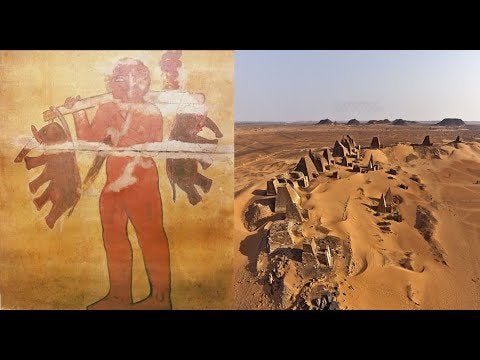Ancient wall painting in the Nubian pyramids depicting a Giant carrying two elephants
If you drive north from Khartoum along a narrow desert road toward the ancient city of Meros, a breathtaking view emerges beyond the mirage: dozens of steep pyramids piercing the horizon. No matter how many times you visit, there is an amazing sense of discovery.

In Meros itself, once the capital of the Kingdom of Kush, the road divides the city. To the east is the royal cemetery, filled with about 50 sandstone and red brick pyramids of varying heights; The legacy of the European robbers of the 19th century has been broken by many. To the west is the royal city, which includes the ruins of a palace, a temple and a royal bath.
Each structure has a distinctive architecture that draws on evidence of global ties to the local, Egyptian and Greco-Roman decorative tastes—Mero.
A Brief History of the “Land of Kush”

The first settlers in North Sudan date back to 300,000 years ago. It is home to the oldest sub-Saharan African state, the Kingdom of Kush (around 2500–1500 BC). This culture produced some of the most beautiful pottery in the Nile Valley, including the Karma Beaker.
Sudan was reputed for its rich natural resources especially gold, ebony and ivory. Many items in the British Museum collection are made of these materials.
Ancient Egyptians were drawn south in search of these resources during the Old Kingdom (about 2686–2181 BC), which often led to conflict as Egyptian and Sudanese rulers sought to control trade.
Kush was the most powerful kingdom in the Nile Valley around 1700 BC. The conflict between Egypt and Kush culminated in the conquest of Kush by Thutmose I (1504–1492 BC). In the west and south, Neolithic cultures persisted as both regions were out of reach of the Egyptian rulers.
Peculiar murals of the city of Meros and the giant carrying elephants
The city of Meros is marked by over two hundred pyramids, many of which are in ruins. They have the typical shape and proportions of the Nubian pyramids.
The site of Meros was brought to the knowledge of Europeans in 1821 by the French mineralogist Frédéric Callioud (1787–1869). The most interesting objects were the reliefs and paintings on the walls of the chambers of the tombs. One of the pictures depicts a giant proportion carrying two elephants.

His features are not Nubian but Caucasian and his hair is light-coloured. Will this mural be evidence of the existence of a race of red-haired six-fingered demons in ancient times?
In the distant past, did demons really roam the Nile Valley?
In 79 AD, the Roman historian Josephus Flavius wrote that the last race of Egyptian giants lived during the reign of King Joshua in the 79th century BC. He further wrote that they had huge bodies, and their faces were so different from those of ordinary humans that it was wonderful to see them, and it was scary to hear their loud voice which was like the roar of a lion.
In addition, many wall paintings from ancient Egypt depict the builders of the pyramids as “giant people” ranging in size from 5 to 6 meters tall. According to experts, these giants were capable of lifting 4 to 5 tons of blocks separately.
Some of those ancient murals showed giant kings ruling ancient Egypt, while some depicted comparatively small-sized servants under giants.
In 1988, Gregor Spori, a Swiss entrepreneur and a passionate admirer of ancient Egyptian history, met a gang of robbers of ancient burials through one of the private suppliers in Egypt.
The meeting took place in a small house in Bir Hooker, a hundred kilometres northeast of Cairo, where Spori saw a giant mummified finger wrapped in rags.

The finger was very dry and light. According to Spori, the incredible creature to which he belonged must have been at least 5 meters (about 16.48 feet) in height. To prove authenticity, a Tomb Raider showed a photo of an X-ray of a mummified finger taken in the 1960s.
